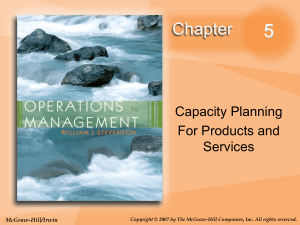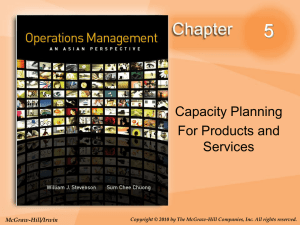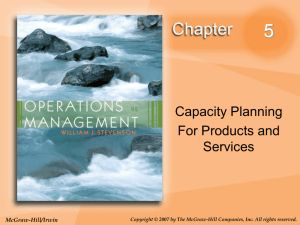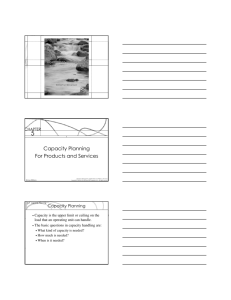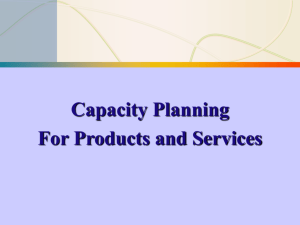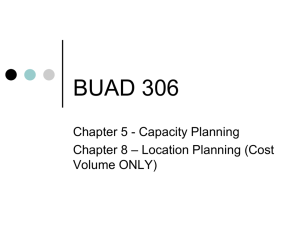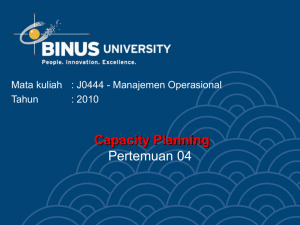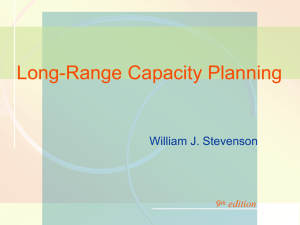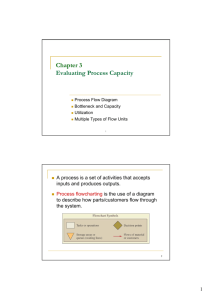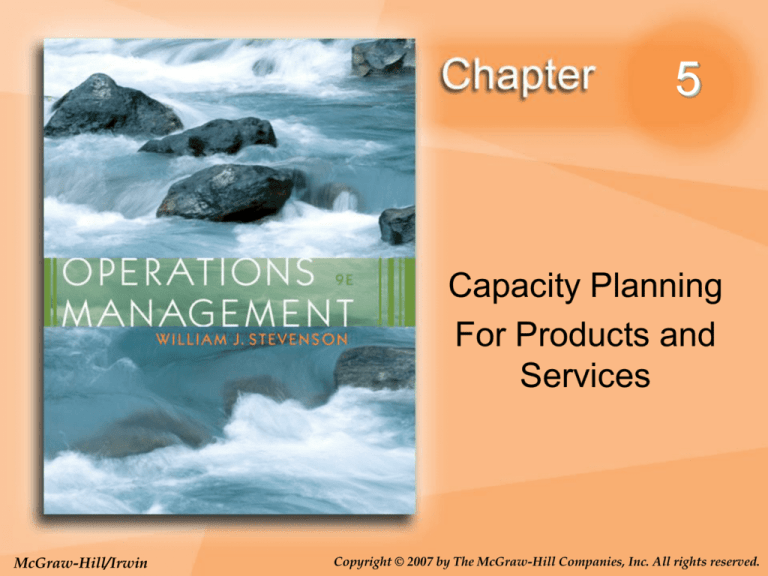
5
Capacity Planning
For Products and
Services
McGraw-Hill/Irwin
Copyright © 2007 by The McGraw-Hill Companies, Inc. All rights reserved.
Strategic Capacity Planning
Chapter 5 - Lesson 2
Lecture/Discussion
Capacity planning – what and why
Measures of Capacity - Utilization and Efficiency
Comparing Capacity Alternatives - Breakeven
Analysis
Management tools exercises:
Capacity Planning Exercise - Running the Business
School
Problem Solving:
Utilization and Efficiency
Breakeven Analysis
5-2
Capacity Planning
Capacity is the upper limit or ceiling on
the load that an operating unit can
handle.
Capacity also includes
Equipment
Space
Employee skills
The basic questions in capacity handling
are:
What kind of capacity is needed?
How much is needed?
When is it needed?
5-3
Importance of Capacity Decisions
1. Impacts ability to meet future demands
2. Affects operating costs
3. Major determinant of initial costs
4. Involves long-term commitment
5. Affects competitiveness
6. Affects ease of management
7. Globalization adds complexity
8. Impacts long range planning
5-4
Capacity
Design capacity
maximum output rate or service capacity an
operation, process, or facility is designed for
Effective capacity
Design capacity minus allowances such as
personal time, maintenance, and scrap
Actual output
rate of output actually achieved--cannot
exceed effective capacity.
5-5
Efficiency and Utilization
Actual output
Efficiency =
Effective capacity
Actual output
Utilization =
Design capacity
Both measures expressed as percentages
5-6
Efficiency/Utilization Example
Design capacity = 50 trucks/day
Effective capacity = 40 trucks/day
Actual output = 36 units/day
Actual output
=
36 units/day
Efficiency =
=
90%
Effective capacity
Utilization =
72%
Actual output
Design capacity
40 units/ day
=
36 units/day
50 units/day
=
5-7
Determinants of Effective
Capacity
Facilities
Product and service factors
Process factors
Human factors
Policy factors
Operational factors
Supply chain factors
External factors
5-8
Key Decisions of Capacity
Planning
1. Amount of capacity needed
•
Capacity cushion (100% - Utilization)
2. Timing of changes
3. Need to maintain balance
4. Extent of flexibility of facilities
Capacity cushion – extra demand intended to offset uncertainty
5-9
Steps for Capacity Planning
1. Estimate future capacity requirements
2. Evaluate existing capacity
3. Identify alternatives
4. Conduct financial analysis
5. Assess key qualitative issues
6. Select one alternative
7. Implement alternative chosen
8. Monitor results
5-10
Forecasting Capacity
Requirements
Long-term vs. short-term capacity needs
Long-term relates to overall level of capacity
such as facility size, trends, and cycles
Short-term relates to variations from
seasonal, random, and irregular fluctuations
in demand
5-11
Calculating Processing
Requirements
Standard
processing time
per unit (hr.)
Product
Annual
Demand
Processing time
needed (hr.)
#1
400
5.0
2,000
#2
300
8.0
2,400
#3
700
2.0
1,400
5,800
If annual capacity is 2000 hours, then we need three machines to handle the
required volume: 5,800 hours/2,000 hours = 2.90 machines
5-12
Planning Service Capacity
Need to be near customers
Capacity and location are closely tied
Inability to store services
Capacity must be matched with timing of
demand
Degree of volatility of demand
Peak demand periods
5-13
In-House or Outsourcing
Outsource: obtain a good or service
from an external provider
1.
2.
3.
4.
5.
6.
Available capacity
Expertise
Quality considerations
Nature of demand
Cost
Risk
5-14
Developing Capacity Alternatives
1.Design flexibility into systems
2.Take stage of life cycle into account
3.Take a “big picture” approach to capacity
changes
4.Prepare to deal with capacity “chunks”
5.Attempt to smooth out capacity
requirements
6.Identify the optimal operating level
5-15
Bottleneck Operation
Figure 5.2
Machine #1
Machine #2
Bottleneck operation: An operation
in a sequence of operations whose
capacity is lower than that of the
other operations
10/hr
10/hr
Machine #3
Bottleneck
Operation
30/hr
10/hr
Machine #4
10/hr
5-16
Bottleneck Operation
Bottleneck
Operation 1
20/hr.
Operation 2
10/hr.
Operation 3
15/hr.
10/hr.
Maximum output rate
limited by bottleneck
5-17
Evaluating Alternatives
Cost-volume analysis
Break-even point
Financial analysis
Cash flow
Present value
Decision theory
Waiting-line analysis
5-18
Cost-Volume Relationships
Amount ($)
Figure 5.6a
Fixed cost (FC)
0
Q (volume in units)
5-19
Cost-Volume Relationships
Amount ($)
Figure 5.6b
0
Q (volume in units)
5-20
Cost-Volume Relationships
Amount ($)
Figure 5.6c
0
BEP units
Q (volume in units)
5-21
Break-Even Problem with Step
Fixed Costs
Figure 5.7a
3 machines
2 machines
1 machine
Quantity
Step fixed costs and variable costs.
5-22
Break-Even Problem with Step
Fixed
Costs
Figure 5.7b
$
BEP
3
TC
BEP2
TC
3
TC
2
1
Quantity
Multiple break-even points
5-23
Capacity Planning Exercise
Running the Business School
What is the major capacity planning issue when operating a
University “School”?
How would you go about developing a strategic capacity plan for
the Stetson School of Business?
What data is important to obtain?
__
__
__
Develop a capacity plan for:
Number of full time professors
Number of adjunct professors
Classrooms (not for this exercise)
5-24
Utilization and Efficiency Exercises
Determine the utilization and efficiency for the
following:
a. A loan processing operation that processes an
average of 7 loans per day. The operation has a
design capacity of 10 loans per day and an
effective capacity of 8 loans per day.
b. A furnace repair team that services an average of
four furnaces a day if the design capacity is six
furnaces per day and the effective capacity is
five furnaces a day.
5-25
Utilization and Efficiency Exercises
In a job shop, effective capacity is only 50 percent
of design capacity, and actual output is 80% of
effective output. What design capacity would be
needed to achieve an actual output of eight jobs
per week?
5-26
Breakeven Analysis
A producer of pottery is considering the addition of a
new plant to absorb the backlog of demand.
The primary location being considered will have
fixed costs of $9,200 per month and variable
costs of 70 cents per unit produced. Each item
is to retailers at a price that averages 90 cents.
a. What volume per month is required in order to
break even?
b.
What profit would be realized on a monthly
volume of 61,000 units? 87,000 units?
5-27
Breakeven Analysis
A producer of pottery is considering the addition of a
new plant to absorb the backlog of demand.
The primary location being considered will have
fixed costs of $9,200 per month and variable
costs of 70 cents per unit produced. Each item
is to retailers at a price that averages 90 cents.
c. What volume is needed to obtain a profit of
$16,000 per month?
5-28
Breakeven Analysis
A small firm intends to increase the capacity of a
bottleneck operation by adding a new machine.
Alternative A Alternative B
Annual fixed cost
$40,000
$30,000
Variable cost/unit
$10
$15
Revenue / unit = $15
a.
Determine each alternative’s breakeven point.
5-29
Breakeven Analysis
A small firm intends to increase the capacity of a
bottleneck operation by adding a new machine.
Alternative A Alternative B
Annual fixed cost
$40,000
$30,000
Variable cost/unit
$10
$11
Revenue / unit = $15
b.
At what volume would the two alternative yield
the same profit?
5-30



